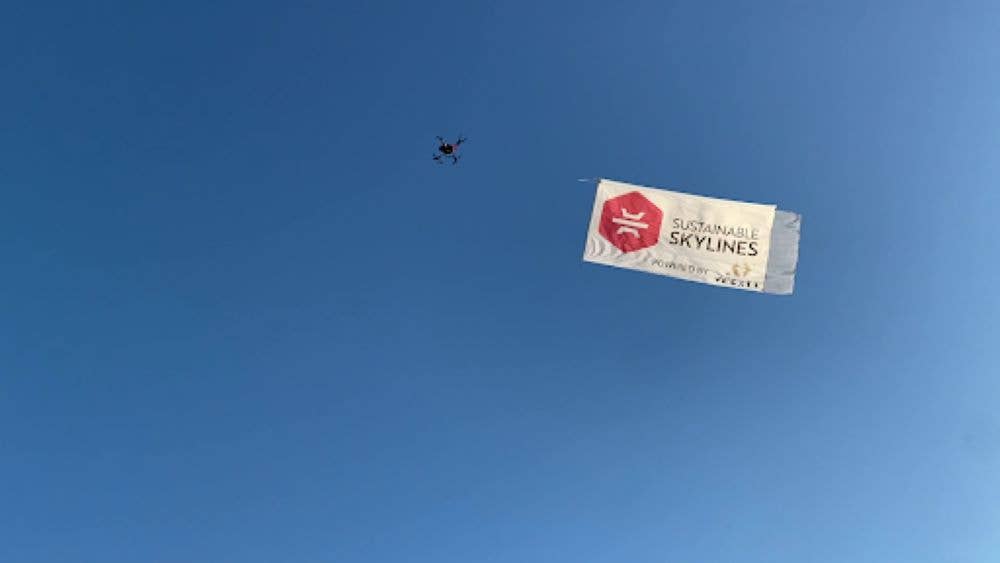Startup Aims To Replace Banner-Towing Aircraft With Drones
Sustainable Skylines claims its drones will reduce the carbon footprint of traditional banner-towing aircraft by 90 percent.

A Sustainable Skylines drone drags a banner a few hundred feet off the ground. [Courtesy: Sustainable Skylines]
For pilots, banner towing is considered an easy way to accrue flight hours or make a little extra money between trips. But a new service could soon eat up some of those flights.
Miami-based Sustainable Skylines on Tuesday announced that it has secured $1 million in pre-seed funding to support the initial launch of a drone-based advertising service, which it positions as a safer, more sustainable alternative to using airplanes.
Addressing one of aerial advertising’s weaknesses, the service will also employ a campaign analytics platform. It’ll rely on a third-party cell phone dataset that tells advertisers how many people were in a location at a given time, giving them an idea of how many eyes were on the banner. The proprietary system would not share personal identifying information.
The company’s drone advertising fleet will comprise hybrid-electric drones manufactured by California-based Velary. They would need just three gallons of unleaded fuel to complete a four-hour flight, compared to 30 gallons of 100LL burned by the average piston single used for towing, which the firm claims can reduce the industry’s carbon footprint by 90 percent.
Sustainable Skylines also claims that using drones would improve safety, though aviation experts say banner flying is not inherently dangerous. However, the service would eliminate the rare cases—around 10 per year in the U.S.—where banner-tow airplanes suffered accidents.
Investors in Sustainable Skylines’ pre-seed round included Jeffrey Zajkowski, former head of Equity Capital Markets at J.P. Morgan; Interstate Outdoor Advertising CEO Drew Katz; Arcadia Power senior vice president of finance and head of corporate development Paul Mulé; and other angel investors and industry executives.
“Our cutting-edge technology cleans up the category's carbon footprint while allowing brands to garner measurable insights in an out-of-home category that has been underutilized in the past,” said Jacob Stonecipher, CEO of Sustainable Skylines.
Though the company promises to reduce emissions in aerial advertising—something that will be crucial for the industry moving forward—drone advertising could have an adverse impact on pilots, many of whom rely on banner towing to earn additional flight hours or income.
While the pilot shortage is ongoing, banner towing has been relatively unaffected given the large pool of aviators who use the one-way, passenger-free flights to bridge gaps in their work. Typically, they also earn between $15 and $50 per hour. Really, the only impediment to pilots is learning how to hook the banner during takeoff.
Drones, however, could offer a cheaper alternative to advertisers. It’s unclear what Sustainable Skylines will charge for its service, and it’s possible that employing pilots will be more cost-effective in the short term. But as the drone industry continues to improve unit economics, those costs may come down—and end up pricing out pilots.
Stonecipher insisted that banner towers will have a role to play in Sustainable Skylines’ service, though he didn’t specify what exactly that role might be.
“To grow [out-of-home advertising] at scale and even bring it to the programmable ad marketplace will require the unique skill sets banner towers have,” he said. “We’re going to need that experience to reap the benefits and ensure the requisite level of safety pilots inherently have to ensure this market grows as fast as we know it can.”
One path the company could take that might preserve pilots’ jobs is offering a premium service. Its drones would fly closer to people than airplanes, and the added benefit of analytics could position Sustainable Skylines as a better, if more expensive, option.
While Sustainable Skylines is the first firm to eye drone banner towing, the bigger concern is that others will pop up. As the unit economics of drone flights allow companies to charge less, the worry is that competition could drive costs down further.
Time will tell if other firms arise to challenge the Miami-based firm. If they do, the industry could become more sustainable. But banner towing may no longer be the reliable hour-building option it is today for pilots.

Subscribe to Our Newsletter
Get the latest FLYING stories delivered directly to your inbox






